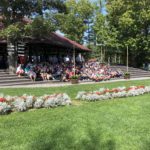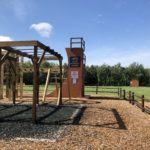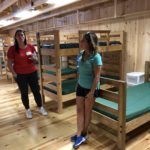In the Spirit of Sharing Ideas and Knowledge, Northeast Camp Professionals Tour Six Maine Camps
Camp directors have bid good-bye to their campers. Staff numbers have shrunk from robust teams to skeleton crews charged with hosting post-season events and closing up facilities. And regardless of the camp, year-round personnel are already looking to 2020. Post-season camp scrutiny leads to planning and possibilities for change, a process demanding time and energy. But camp directors, regardless of their camps’ size and location and mission, agree that evaluating their facilities and programs – and making decisions about improvements – benefits enormously from collaboration.

For three days in early September close to 150 camp professionals from the U.S. and Canada engaged in such collaboration here in Maine. In joint initiative of the American Camp Association (ACA), New England and ACA, New York and New Jersey, the participants toured six resident camps in the Sebago Lakes region of Maine. The event proved a fitting opportunity to look outward, from the focus of exhilarating and exhausting in-season camp operations, to the rewards of collegial professional engagement and a look how other camps get the job done.
The tour began Sept. 10 at girls’ camp Fernwood Cove in Harrison. The next day the group began at Camp Micah in Bridgton, followed by a tour and lunch at girls’ Camp Mataponi in Naples, and ending with a tour, socializing, and dinner at Casco’s Camp Sunshine, a nonprofit organization which serves children with life-threatening illnesses and their families. The event concluded on Thursday, with tours of girls’ Tripp Lake Camp in Poland and Kamp Kohut, a brother-sister camp in Oxford.
“They loved seeing the properties. And camps felt good about getting to share their camps with other professionals in the community,” said Kerry Salvo, ACA, New England director of education and professional development.
The event’s informality – walking tours that allowed attendees to ask questions of their tour guides and chat with other registrants – maximized the benefits of connecting with new colleagues, Salvo said. “It’s so valuable to get to learn from each other. They realize they’re not in a bubble.”
The tour was designed to focus in large part on camps’ facilities and infrastructure, Salvo said. Such fact-finding opportunities are rare, she said, and helped drive the choice of what camps to visit. “We wanted to make sure that we were choosing camps that would draw people,” she said.

An additional consideration was that many resident camps face issues around aging facilities and infrastructure, Salvo said. Being able to visit camps that are “young,” such as Camp Micah (founded in 2001) and Fernwood Cove (established in 1998), can provide useful guidance in considering renovations or upgrades, Salvo said. For example, camp directors seeking to update or replace dining halls or health centers will find that “there are many different ways to approach it.”
The tour also allowed attendees to gather specific information related to project costs and specific materials used, she said.
“Some of it is new ideas, some of it is nitty gritty,” Salvo said. “Septic systems are not something we ordinarily talk about, but it’s real. You need to have a plan.”
Issues around energy use and sustainability also come up, she said. For example, Fernwood Cove utilizes solar panels: “it’s not just energy efficient, there’s a cost savings,” Salvo said.
Salvo said that visiting Camp Sunshine provided several unique benefits. First, “for us, it’s always really important that one camp we visit is a nonprofit camp.”
Camp Sunshine, whose campus on the shores of Sebago Lake opened in 2001, annually offers about 25 illness-specific camp sessions for ill children and their families – entirely free of charge. “It is kind of a natural fit for us,” Salvo said. Information about the camp’s “amazing facilities” can be transferable to other camps, she said. In addition, “it’s really moving and inspirational to see there’s this community serving kids that couldn’t go to [traditional] camp.”

The six participating camps in the event “made it really easy,” Salvo said. “We did planning calls, but they really took the idea and ran with it. I’m so impressed with how much they embraced it.”
Susie Lupert, ACA, New York and New Jersey executive director agreed: “it couldn’t have gone better.”
“Everyone who goes and buys into [the annual camp tour event] keeps coming back,” Lupert said. “The reason is that here there’s just no better way to learn. It’s experiential, not just reading, or a lecture.”
Lupert said a primary goal of the annual event is to offer participants exposure to “a diversity of camps” in terms of programs, facilities, and “the look of it.” Organizers also seek to combine both for-profit and nonprofit camps in the tours. This allows for-profit camp operators to “look at nonprofits differently,” said Lupert. In addition, “we want nonprofits to be able to look at others and say, ‘wow, this is really aspirational.’” Facilities, technology, and program elements are all key, she said.
“Every camp was really different,” Lupert said. The ability to visit six camps and be able to “distinguish them in your minds really well, be able to point to things that make them feel unique,” signifies a successful tour, she said. Plus, the chance to see both a Tripp Lake Camp building from 1913, and Camp Micah built less than two decades ago, “was super cool.”
The collegial networking opportunities offered by the tour are “unique to our industry,” said Lupert. Even if camps are competitors, recruiting from the same potential camper pool, camp personnel are colleagues and friends, she said.
Carly Rapaport Vargas, associate director at Kamp Kohut, which hosted the final tour, called the event “great.”
“It all went so smoothly. Everyone was so appreciative.”

Kamp Kohut, founded in 1907 by a New York educator committed to providing outdoor experiences to boys, has been owned and operated for nearly 30 years by husband-and-wife team Dan Rapaport and Lisa Tripler. Upon acquiring the camp, the couple added a girls’ program; Tripler calls it a brother-sister camp.
Kamp Kohut’s age means “we do look a little different,” Vargas said. This offered attendees another, different, experience. In addition, Vargas said attendees could focus on different topics as they looked at the camp. Tour information ranged from camper programming and staffing issues, to outdoor education, to history and philosophy, to operations. Kohut personnel described the challenge of acquiring internet service, as well as the challenges of “having an old camp and bringing in new stuff” related to technology and infrastructure, Vargas said.
“They wanted to see it all,” she said, including a chat with the camp’s beloved “head laundry lady,” who oversees the on-site laundry operations. Questions were abundant as well, she said, including logistics like vendors’ phone numbers.
“We don’t get to see these camps,” Vargas said. “As emerging professionals, we get to see how they’re doing things.”
“We’re always trying to make camp better,” said Nora Krainis, associate director of western Massachusetts’ Camp Taconic. Krainis, who teaches music at North Yarmouth Academy in the off-season, said that from program to facilities, exchanging information is invaluable. Collaborative gatherings mean, “It’s not every man for himself.” Krainis says. “The mom and pop camps don’t lose out.”
ACA, New England Executive Director Bette Bussel, in introducing the first stop last Wednesday, sang the praises of Camp Micah’s 10-month construction from beginning to end. Perched on a hill above Peabody Pond in Bridgton, the Jewish camp is directed by Mark Lipof, a licensed social worker who told the group that he knew from age 11 that he wanted to own a camp. Funded by a group of private investors, Camp Micah opened in the summer of 2001, Lipof said. A month after that first session ended, 9/11 took place. “I wondered if we’d survive,” he said.
They have indeed. The upcoming season will be Camp Micah’s 20th summer.
Lipof did not hesitate to describe how the camp has addressed security concerns. An electric gate sits at the camp entrance and the property is staffed by uniformed and armed security personnel overnight.
“We’re a Jewish camp,” living in times of hatred, Lipof said. “Everyone said ‘thank you for being proactive.’”

One of Camp Micah’s major attractions is its Ninja Warrior course, based on the courses used in the high-ratings reality television show “America Ninja Warrior.” The Micah obstacle course includes the infamous challenge, the “Warped Wall,” scaled by participants via a running approach and technique-based ascent. The challenge “builds resilience,” Lipof said. In fact, the camp’s facilities manager, Mike Fusco, said Micah campers have been known to keep trying, summer after summer, until they scale the walls.
The camp offers a vast range of activities – from art to music to athletics, plus a skateboard park and street hockey rink. Swim lessons take place in a Junior Olympic-sized pool, and campers enjoy all manner of water sports.
“The program is very simple,” Lipof said, “but it’s hard to do.”
Scott Graham, director of Camp Can-Aqua in Ontario, Canada, said he is impressed by the variety of different camps. “It’s a nice time to reflect on our own camp,” while also observing others, he said.
Trish Kittredge, director of operations at The Susquehannock Camps in Brackney, PA, also made the trip to Maine. The 115-year-old camp has a new director and is embarking on a period of growth, Kittredge said. Susquehannock Camps are far more rustic than Camp Micah, she said – such as no air-conditioning in staff housing, and outhouses instead of in-cabin bathrooms. Still, Kittredge said, she was looking for ways “to improve, and to see how we’re doing.”
At girls’ Camp Mataponi in Naples, owners Dan and Marcy Isdaner briefly described their 27-year ownership of the girls’ camp, which will mark its 110th year in the 2020 season. Visitors enjoyed a full tour of the camp’s activities offerings and learned a bit about the facility’s tankless water heaters, generators, well system, and newly adopted towel service. The service – which translates to 2,000 towels laundered per day – means the 325 campers leave their towels home and receive fresh towels at the waterfront and for showers. The result: more storage space for campers’ belongings in cabins, and a lower incidence of potential infections, said Marcy.

The camp, marked primarily by white clapboard buildings with green trim, also posts symbols of campers committed to the benefits of their summer home. Hand-painted signs hang throughout the campus displaying optimistic messages and signed with the initials of their creators. The tradition began more than a dozen years ago, Marcy explained, and is now evident by an array of signs. One describes friends as “Hard to make: harder to leave; impossible to forget;” and another suggests, “It’s nice to be important, but more important to be nice.”
As she walked through the campus, Samantha Menzel, a Tripp Lake Camp employee for more than ten years, said she registered for the event to gain new ideas, from the “little things” to camps’ overall approaches.
Similarly, Emily Yancey made the trip from upstate New York to gather information as she prepares to assume primary responsibilities from her father at the camp her family has operated for 75 years. Located on Upper St. Regis Lake, Camp Regis-Applejack is a traditional, non-denominational camp, Yancey said.
“I’ve taken six pages of notes!” she said. Particularly helpful was camp directors’ willingness to be “candid” about costs and other details associated with project construction or improvements, she said.
“They don’t want you to make the same mistakes” they might have made,” said Catskills-based Camp Loyaltown Director Savita Sharma. Sharma, who holds a doctorate in physical therapy, has been at the helm of the camp – which serves youngsters with special needs – for six years. By encouraging camp personnel to learn from each other, Sharma added, directors “show the sign of a true professional.”
Wednesday’s tour ended at Camp Sunshine in Casco. As Executive Director Mike Katz told the visitors, the camp was founded by Dr. Lawrence and Anna Gould to “provide respite, recreation, and support for children with life-threatening illnesses,” completely free of charge. Camp Sunshine’s permanent home opened in 2001; between 2000 and 2500 volunteers contribute their efforts to the operation annually, Katz said.
Co-founder Anna Gould led one of the Camp Sunshine tours, walked guests through the 24-acre campus and described details of the camp’s operation. A maximum of 40 families attends each camp session, which are a little less than a week in length. Children participate in age-appropriate, traditional camp activities, from swimming to crafts to campfires, she said. Parents enjoy their own respite and join their kids for meals and time in the evenings. The families stay together in one of the camp’s 70 suites.
“For one week, these children feel ‘normal’” because they are among other kids suffering from the same illness, Gould said. “To see that is a great gift.”
In addition, to sharing the camp’s beautiful facilities, the tour also demonstrated “the connection to work people are doing, and how camp affects everybody,” Lupert said.
Anna Gould said she hoped the visiting camp professionals came away with two key impressions. First, Camp Sunshine always seeks volunteers. Individuals can’t always contribute financially to the camp, but may be able to help by volunteering their time, she said. Second, she made a request echoed later in the evening by Katz, urging tour participants to reach out to families who might benefit from attending the camp.
Kerry Salvo of ACA, New England said the collegial spirit of last week’s tour was emblematic of how the camp community works.
“We aren’t reinventing the wheel,” Salvo said. “Sharing resources helps us do our jobs better.”